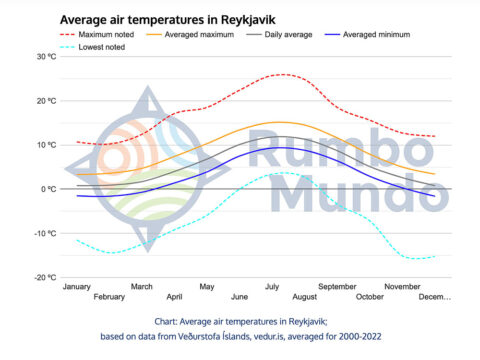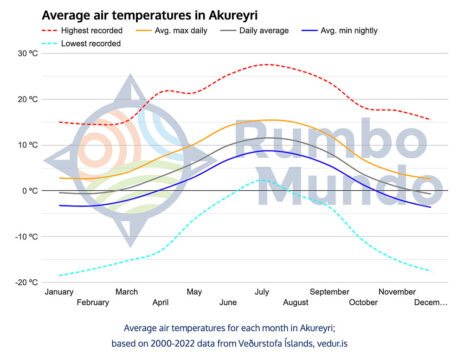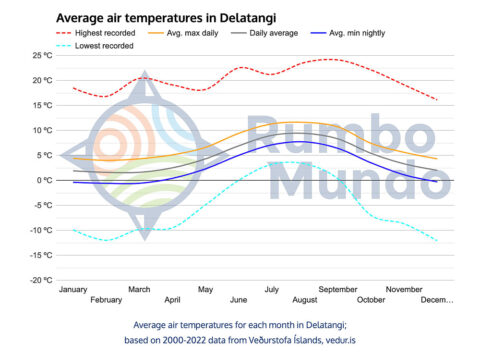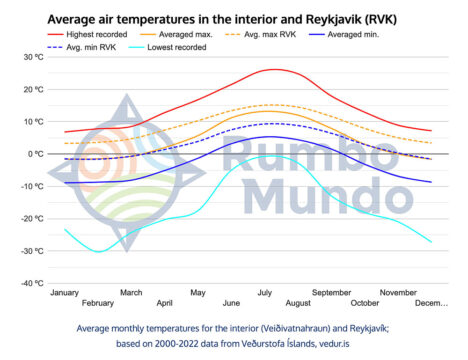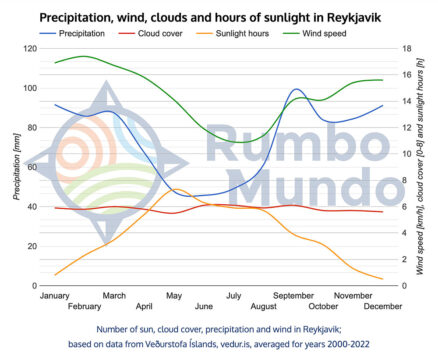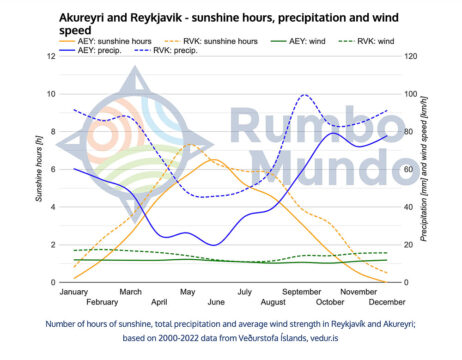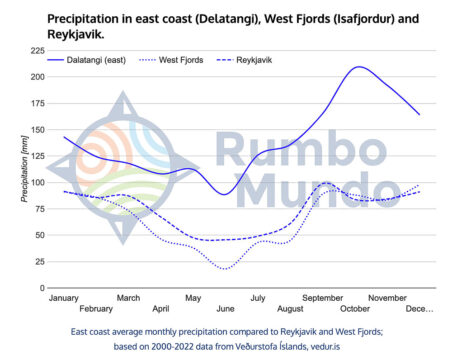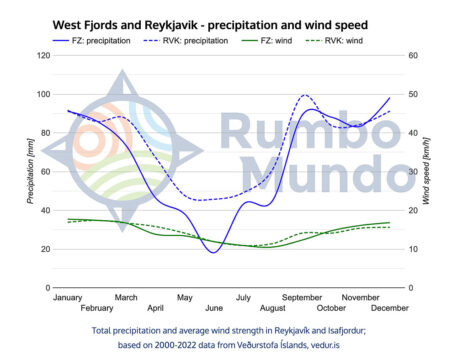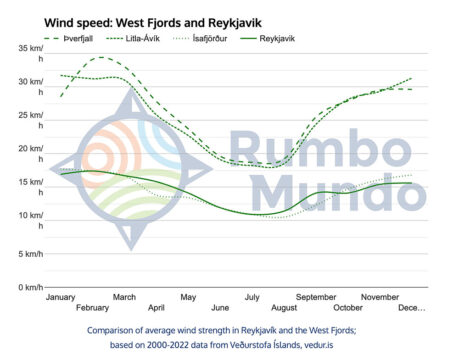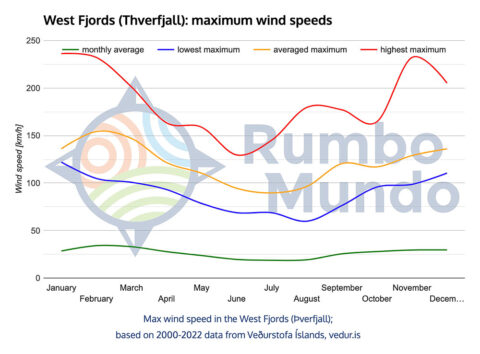As we mentioned in the article about weather in Iceland, the climate or weather in different corners of Iceland differs. And although these differences are rather limited, they are interesting and sometimes even significant. Therefore, below we will discuss the most important ones in comparison with Reykjavik.
If you are interested in the weather in the south of Iceland and around Reykjavik, take a look at the article Weather in Iceland – temperature, wind, precipitation This article is just based on analysis of meteo data from the south and southwest of Iceland.
West Fjords weather
The West Fjords are famous as the most beautiful, but also the most weather-challenged corner of Iceland. And the statistics largely confirm this, although the situation is more complicated than many might expect. In the analysis, we rely on data from the region’s capital, Ísafjörður.
The average maximum temperature here is lower than in Reykjavik by about 0.5 °C to 2.5 °C throughout the year. Minimum temperatures are about 2 °C lower year-round. So the differences are not huge. The West Fjords are not the “cold pole” of Iceland (that pole is the interior, but more on that later).
Comparison of average temperatures for individual months in Reykjavík and Isafjordur;
based on 2000-2022 data from Veðurstofa Íslands, vedur.isIn the graph above, it is worth noting that the average minimum temperature here falls below 0 °C (32 °F) a month earlier (in November), and returns above that level a month later than in the capital, as late as May. Strictly speaking, as we have already indicated above, the climatic winter is considered to be the period when the average daily temperature falls below 0 °C (32 °F), and this in Isafjordur happens only in February. However, this average is 0.06 °C in December, 0.02 °C in January, and 0.04 °C in March. So sticking to the opinion that winter comes here only in February, and the rest of these months are just pre-winter would probably be too rigid.
‘By
the book’, i.e. according to the average daily temperature, winter appears in the West Fjords (or more precisely: in Isafjordur) only in February. But if we switch to the average minimum temperature, winter in the West Fjords lasts as long as half a year: from November to April.
The Ísafjörður station does not collect information on the number of hours of sunshine or cloud cover, but based on data from other stations in the region, it is safe to say that the differences from Reykjavík are negligible in this regard.
Interestingly, the average wind strength here is also surprisingly similar to Reykjavik throughout the year. On the other hand, rainfall totals for individual months here are noticeably lower than in Reykjavik from March through September, but outside of those months remain similar to the capital.
Total precipitation and average wind strength in Reykjavík and Isafjordur;
based on 2000-2022 data from Veðurstofa Íslands, vedur.isSo is the West Fjords’ bad reputation unjustified? That would be a premature conclusion. After all, the West Fjords are primarily famous for snow and wind.
The thickness of the snow cover and its duration is unfortunately not tracked by weather stations. But as we mentioned earlier, temperatures here drop below zero at night for as much as half the year. Snow, especially in shaded areas, and these are not difficult to find in the mountainous fjords, therefore has excellent conditions to last very long here.
On the other hand, measuring the strength of the wind in Isafjordur is misleading to the extent that the town is not located in a random place, but in the depths of a well-hidden fjord bay, among rather high hills. Thus, it blows much less here than on the surrounding hills and passes. Isafjordur is well sheltered from the wind, but in unshielded places the wind in the West Fjords acts differently.
If we look at the data of the Þverfjall station located in the hills surrounding Isafjordur (only 7 km west of the city, but at an altitude of 741 m above sea level), the wind graph already looks quite different. Anyway, Thverfjall looks like a station more representative of the whole region in terms of wind strength, because, for example, the Litla-Ávík station located at the small Gjögurflugvöllur airport in the eastern part of the region and just above the ocean (only 15 m above sea level) shows very similar records in this respect.
Comparison of average wind strength in Reykjavík and the West Fjords;
based on 2000-2022 data from Veðurstofa Íslands, vedur.isAs you can see from the chart, on average, throughout the year, the winds on Thverfjall are almost 80% stronger than in Reykjavik. In March and October this ratio even exceeds 97%. This means that in these months (on average!) the wind blows twice as fast here. The graph also clearly shows that the wind in Litla-Ávík is very similar to that on Thverfjall, even though the Litla-Ávík station is not located on a high hill, but just above the ocean.
Even in the month of the weakest wind – July – it blows more in the hills above Isafjordur (18.7 km/h – 11.6 mph) than in Reykjavik in the month of the highest wind (February – 17.4 km/h / 10.8 mph).
But again – these are only averages. We will only get the full picture when we also look at the extreme recorded wind speed.
A small methodological note: the graph below was created from collecting the maximum recorded wind speeds in a given month from January 2000 to December 2022. From these values for each month (i.e., for example, for all of February or all of October), we select the highest indication, the lowest, and calculate the average of all 23 indications. For comparison, we also include the monthly average shown earlier (the one 80% higher than Reykjavik). This way we get the data as below:
Max wind speed in the West Fjords (Þverfjall);
based on 2000-2022 data from Veðurstofa Íslands, vedur.isNaturally, the graph of maximum wind speeds here, is “a completely different league.” The yellow line on the graph (average maximum) only drops below 100 km/h (62 mph) three times (June – August), and at its highest point (February) it reaches as high as 154.3 km/h (95.9 mph)! At the same time, let’s remember that these are values averaged for all years. That is, for example, for each February from 2000 to 2022 we take the maximum recorded wind speed, and then from these 23 values we draw an average. And that average for February is just 154.3 km/h (95.9 mph).
The highest wind speeds ever recorded here exceed 230 km/h (143 mph) for as many as three months, and 200 km/h (124 mph) for five (November through March). But these, in turn, are extremes that (precautionary) tourists do not encounter, because red alerts are issued before such storms and it is strongly suggested to leave the region quickly. During such strong storms, of course, the roads are closed, but even so, no one can think of leaving home at that time. However, it is worth remembering that such winds also happen here.
On the other hand, perhaps the most shocking is the blue line on the graph. That’s the line showing the “lowest maximum” from 2000 to 2022. If for each month between 2000 and 2022 we take the HIGHEST wind speed recorded in that month, but then see which was the LOWEST during those 23 years, we find that those results from December to March exceed 100 km/h (62 mph)! That is, every year, in each of these months, the Thverfjall station in the West Fjords recorded wind speeds exceeding 100 km/h (62 mph) at least once. In addition, also in April, October and November these minima fell above 90 km/h (56 mph). From the perspective of Iceland’s capital, the storm actually lasts twelve months in the West Fjords….
In
each and every December, January, February and March from 2000 to 2023, winds in excess of 100 km/h (62 mph) have been recorded at least once in the West Fjords!
The roads in the West Fjords are mostly routed along the coast, an area where the weather is similar to Isafjordur. However, if you want to go around the region, at least twice we have to enter passes lying more than 400 m above sea level. One of these places is near the junction of roads 61 and 608, and the other at the junction of roads 60 and 63. And if you want to visit the Raudasandur beach and Latrabjarg cliffs then you will go over 400 meters above sea level for the third time on Road 62 (and over 360 meters above sea level once again on Road 614). Overcoming these passes is the main problem in moving through the Western Fjords in winter (that is, from November to April!).
Very strong winds, long-lasting snow and several dangerous passes make it necessary to plan a trip to the West Fjords at least from autumn to spring with extreme caution.
As
you can see the best time to visit the beautiful West Fjords are certainly the summer months. Temperatures then are reasonably high, precipitation quite low, and the wind – for this part of the country – a bit weaker.
You can read about what to see when going to this beautiful corner of Iceland here: What to see in the West Fjords
Weather in the north of Iceland
Going clockwise in the next step, we will discuss the weather in the north, based on data from the weather station in the region’s capital, Akureyri Like Isafjordur also this city is tucked away in a deep fjord, and is also quite far south of Iceland’s most northern coast. However, it is certainly the most important city in the region (and the second largest city in Iceland), so we will use it as a benchmark for the entire north.
You can read about the attractions and most interesting places to visit in northern Iceland here: Attractions in northern Iceland
In terms of temperatures, Akureyri is quite similar to Reykjavik. The average maximum temperatures of each month here differ by no more than 1 °C (2 °F), the average minimum temperatures by no more than 2 °C (4 °F). With one and the other in winter are lower, but in summer are higher than in Reykjavik.
Average air temperatures for each month in Akureyri;
based on 2000-2022 data from Veðurstofa Íslands, vedur.isHowever, the differences between recorded extreme temperatures are greater here – from November all the way to December, this difference is more than 30 °C (54 °F)! No month in Reykjavik has recorded such different extreme values. So I guess you could say that temperatures here are similar to Reykjavik, although (even) more erratic.
As well as air temperature, other weather factors behave similarly to Reykjavik in Akureyri, although of course they differ somewhat. Attention is certainly drawn to the number of hours of sunshine, which drops to practically zero here in December and January.
Remember that the number of hours of sunshine is not the same as the length of the day. In winter, a day in Akureyri lasts only 3h 05′, but in summer it is as long as 23h 32′ [source: Einarsson]. That’s 1h less and 2.5h more than in Reykjavik, respectively.
The precipitation minimum here is slightly earlier than in Reykjavik, from April to June, and takes noticeably lower values. June’s minimum value of 19.8 mm is less than half of the lowest rainfall in Reyjkiavik (45.7 mm).
Number of hours of sunshine, total precipitation and average wind strength in Reykjavík and Akureyri;
based on 2000-2022 data from Veðurstofa Íslands, vedur.isAlso characteristic is the relatively weak and little variation in winds, which range between 10.2 km/h and 12.2 km/h (6.3 and 7.6 mph) throughout the year, which are characteristic of the least windy, summer, months in Reykjavik. However, this is probably a characteristic of Akureyri itself, which lies in the aforementioned deep fjord. Further up the northern coast, the wind is certainly more like that of the West Fjords (i.e., it blows its head all year round).
S
imilarily to the West Fjords, the best conditions for visiting Akureyri are in June. Then we have high temperatures, a long day, weak wind and little rainfall.
The best way to visit northern Iceland is on a tour around the island. Due to the cost and weather, the best time for such a trip is May and June (July and August are clearly more expensive). The exact recipe for such a trip can be found here: Spring Iceland trip itinerary: 7 to 13 days
Weather in eastern Iceland
The chosen meteorological data measurement point representing eastern Iceland is Dalatangi, which lies about 40 kilometers east of the region’s capital – Egilsstadir – and is almost (sic!) the easternmost point in Iceland. Dalatangi lies at the eastern end of Highway 953, running past, among other things, the Klifbrekkufossar waterfall. It is the southern shores of the fjord leading to the main port of eastern Iceland – Seyðisfjörður.
You can read about the attractions and most interesting places to visit in eastern Iceland here: Attractions in East Iceland
The climate of the east coast is closer to the north than Reykjavik, but at the same time this means that it is similar to both places. In summer, the average maximum temperature here does not exceed 12 °C (54 °F; versus 15.1 °C (59.2 °F) in Reykjavik), while in winter it does not fall below 4.0 °C (39 °F; versus 3.3 °C (38 °F) in the capital). Minimum temperatures in winter are a bit (up to 1 °C) higher than in the capital, and up to 2 °C higher in summer. So these are not big differences, but one could say that the climate here is a tad more maritime.
Average air temperatures for each month in Delatangi;
based on 2000-2022 data from Veðurstofa Íslands, vedur.isThe station in Dalatangi does not collect data on the number of hours of sunshine, and the cloud cover index does not differ from the Reykjavik norm.
In contrast, the wind here is stronger than in the capital. At the same time – for most of the year, however – it is a noticeably weaker wind than that of record, at Þverfjall in the West Fjords.
East coast average wind speed compared to Reykjavik and West Fjords;
based on 2000-2022 data from Veðurstofa Íslands, vedur.isThe month with the weakest wind (July) recorded an average of 16.9 km/h (10.5 mph), which would be the second highest in Reykjavik – just behind February and ex equo with January. December turns out to be the windiest here, but the result of 24.1 km/h (15 mph) compared to the West Fjords is still rather moderate.
A distinguishing feature of the east coast, however, is the high precipitation.
East coast average monthly precipitation compared to Reykjavik and West Fjords;
based on 2000-2022 data from Veðurstofa Íslands, vedur.isThe month in which this total is lowest is June, which records an average of 88.6 mm of rain. This is only slightly less than such a total for the most (sic!) rainy months in the West Fjords and Reykjavik.
All months other than June record more, usually much more, rainfall in the east than any month in the capital or the northwest…. October, a record in the east, recorded more than 200 mm of rain (the average for the last 23 years!), where in Reykjavik no month exceeds the 100 mm limit!
K
ey feature of the east coast weather is the exceptionally high rainfall. Except for June (88.6 mm), all months (sic!) here record more than 100 mm of precipitation per month (on average for the last 23 years). Meanwhile, no other region in Iceland (sic!) exceeds this limit in any month (sic!). Naturally it is June, that we recommend as the best month to visit east Iceland.
Weather in Iceland’s interiors and highlands
Iceland’s interior is a huge area and very diverse – every day and every moment at different ends of it can have completely different weather. The Veiðivatnahraun station will serve as a landmark of the highlands, while also showing well how they differ from the rest of the island. It lies east of the F26 road, on the western slopes of the Vatnajokull glacier, about 45 km northeast of Hrauneyjar and also ca. 45 km, but to the southwest, from Nyidalur (i.e., the almost perfect geometric center of Iceland).
You can read about the attractions and most interesting places to visit in the Icelandic interiors here: List of interesting places in the interior and here: List of Interesting Places of the Icelandic Interior [Top10]
Veidivatnahraun is located at an altitude of 647 m above sea level, so at an altitude similar to the popular Landmannalaugar (about 610 m above sea level. ), but slightly lower than Dreka near Askja (about 780 m a.s.l.) or just Nyidalur (also about 780 m a.s.l.). However, many mountain huts and campgrounds are located even higher (e.g., Fimmvörðuháls or Hrafntinnusker Hut lie at over 1,000 m above sea level).
The most important characteristic of the interior is certainly the cold. From June to August, maximum temperatures here are about 2 °C lower than in Reykjavik, and minimum temperatures are as much as 4 °C lower. In winter, this difference even widens: the average MAXIMUM temperatures for the interior then almost perfectly coincide with the average MINIMUM temperatures in Reykjavik. However, in winter the roads to the interior are closed and it is practically very difficult to visit it then.
Average monthly temperatures for the interior (Veiðivatnahraun) and Reykjavík;
based on 2000-2022 data from Veðurstofa Íslands, vedur.isFrom a tourist’s perspective, it is certainly also important to note that although in summer the maximum recorded temperatures here exceed 20 °C (68 °F), the lowest recorded temperatures throughout the year tend to be negative. When going camping here, keep in mind that even in July we have to reckon with the risk of frost and snowfall. And yet – as we pointed out earlier – there are several campgrounds in Iceland located quite a bit higher than the Veidivatnahraun station.
Interior is also the only one of the analyzed regions where the lowest recorded temperatures fall below -20 °C (-4 °F), and the record (in February 2008) even exceeded -30 °C (-22 °F)!
The station does not collect data on cloud cover and number of hours of sunshine, but based on data from other stations in the region, it can be seen that these factors are not significantly different from other regions in Iceland.
However, wind strength is higher here, and monthly precipitation totals are more even throughout the year:
Average precipitation and wind strength for the interior (Veidivatnahraun) and Reykjavik;
based on 2000-2022 data from Veðurstofa Íslands, vedur.isWell, unfortunately – while everywhere else in Iceland the summer is noticeably drier than the rest of the year, it rains more or less the same all year round in the interiors. Average monthly precipitation here remains at 50-80 mm for all 12 months.
You can also see from the graph above that it really blows hard here. The average wind speed remains clearly above the indications for Reykjavik throughout the year, and at the same time at levels very similar to the Thverfjall hill in the West Fjords described earlier. Only in February and March is the interior inferior to the Fjords in this regard, as the average wind speed here does not exceed 30 km/h (19 mph). Combined with the bivouacs, which sometimes lie even higher than this weather station, it is not surprising that this is where the interesting phenomenon of “nights of flying tents” is observed in summer….
E
ven in summer, temperature in the interior is several degrees lower than in the rest of Iceland, there can always be frost and snow, and there is the wind is almost always extra strong there. If you plan to sleep under a tent there, you need to be prepared for really harsh conditions.
Available meteo data does not yet show one important feature of the interior – the thickness of the snow cover and the length/period of snow. The region’s inaccessibility is certainly also influenced by the fact that roads here are exclusively gravel and often crossed by streams. And glacial rivers are deepest in summer – after all, the amount of water in them depends on the rate of glacial melt. In winter the interior is inaccessible due to snow, and in spring and summer – due to overflowing streams…. You can read about the most important roads in Iceland and the conditions on them here: The most important roads in Iceland
Meteograms of selected weather stations
